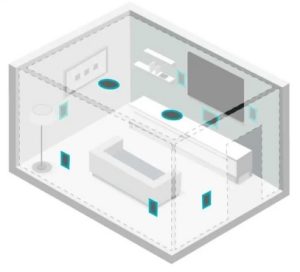In-Wall vs In-Ceiling Speakers: Which Is Right for Your Home?
When designing a home audio system, one of the most important decisions you’ll make is choosing between in-wall vs in-ceiling speakers. Both offer sleek, space-saving solutions that eliminate the need for bulky, traditional speaker setups, but they serve different purposes and shine in different environments.
In-ceiling speakers are ideal for ambient, whole-home music that fills your space without visual distraction, while in-wall speakers provide more focused, directional sound that’s perfect for dedicated listening or home theater setups.
Understanding the strengths of each option can help you create a system that sounds incredible and fits seamlessly into your living space. In this guide, we’ll explore the differences between in-wall and in-ceiling speakers to help you decide which is the best fit for your needs.

Choosing Between In-Wall and In-Ceiling Speakers
Although both in-ceiling and in-wall speakers offer a sleek, space-saving alternative to traditional speaker setups, they each serve distinct purposes and excel in different environments. Understanding the core differences between the two is essential when planning a home audio system that matches your lifestyle and listening preferences.
In-ceiling speakers are best suited for creating ambient, whole-home music. They’re ideal for areas like kitchens, hallways, bathrooms, or open-plan living spaces where audio is meant to fill the room evenly without drawing attention to its source. Positioned above, they disperse sound down and outward, making them ideal for background listening.
In-wall speakers, on the other hand, are more directional and better suited for rooms where focused, immersive sound is the goal. They’re often used in home theaters or media rooms, where ear-level placement enhances stereo imaging and clarity. By aiming sound directly toward the listener, in-wall speakers provide a more engaging, high-fidelity experience.
In-Wall Speakers: For Focused Listening and Theater Rooms
In-wall speakers are an excellent choice for spaces where sound quality and directionality matter most. Unlike ceiling speakers, which cast sound downward and outward for ambient coverage, in-wall models deliver audio at ear level, making them ideal for focused music listening or building a dedicated home theater.

Their placement allows for precise stereo imaging, creating a defined “sweet spot” where the listener can fully appreciate depth, detail, and clarity.
For music lovers, in-wall speakers bring out the richness of vocals and instruments in a way that background systems often can’t. They’re designed to deliver a front-facing audio experience, and can make you feel like the performance is happening live in front of you.
In home theaters, they play a key role in constructing a surround sound environment. When used for left, right, and center channels, they anchor dialogue and on-screen action while maintaining a clean look with no floor-standing speakers in sight.
Ceiling Speakers: For Whole-Home Music Bliss
Ceiling speakers are the go-to choice for homeowners looking to create a seamless multi-room audio experience. Whether you’re hosting guests or just moving from room to room during your day, in-ceiling speakers provide consistent, background music without the visual distraction of freestanding equipment.
Their discreet design makes them particularly effective in open-concept living spaces, kitchens, bathrooms, and hallways—anywhere you want music to follow you.

When planning a ceiling speaker setup, the size and layout of each room should guide the number of speakers you install. A small room like a dining area might only need one or two speakers for balanced coverage. Larger rooms, especially those with high ceilings, may need several speakers strategically spaced to ensure even volume and clarity throughout.
Proper placement is just as important as quantity. Speakers should be positioned to minimize dead zones and prevent sound from being too concentrated in one area. With careful planning, in-ceiling systems can deliver immersive, room-filling sound that feels natural and effortless.
Add a Subwoofer: Completing the Low-End
No audio system is truly complete without a subwoofer. While in-wall and in-ceiling speakers are excellent for mids and highs, they often lack the depth needed to fully reproduce low frequencies.
For those seeking a clean aesthetic, in-wall or in-floor subwoofers offer an elegant solution. These discreet models can be built directly into your wall or floor, blending in with your space while delivering the deep bass performance typically associated with larger, external subs. They’re powered by external amplifiers, allowing for more flexible placement and reduced visual clutter.
Whether you’re building a multi-room music setup or a high-performance home theater, integrating a subwoofer ensures your system delivers full-range audio. It’s the missing piece that turns great sound into an immersive, emotionally engaging experience.
Installation Tips and Must-Have Accessories
Proper installation is key to getting the best performance from your in-wall and in-ceiling speakers. One of the most important considerations is the wiring.

Always use UL-rated speaker wire: CL2 or CL3 for in-wall runs. These cables are designed to meet fire safety codes and are more durable than standard wire, ensuring safe and long-lasting performance.
Choosing the right gauge wire also matters, as longer runs may need thicker wire to maintain sound quality.
If you’re building or renovating, pre-construction brackets are a smart addition. These metal or plastic frames are mounted between studs or joists before the drywall goes up, marking the exact spot for each speaker. They help simplify installation, provide a stable mount, and ensure the speakers are aligned properly during the final phase of construction.
To reduce sound transfer between rooms—especially when speakers are installed in ceilings below bedrooms or quiet areas—consider models with built-in back boxes or add aftermarket enclosures. These will help contain the sound and also improve bass performance by creating a controlled acoustic chamber behind the speaker.
In-Wall vs In-Ceiling Speakers: Sound That Blends In, Not Out
In-wall and in-ceiling speakers are the perfect fusion of form and function, delivering high-quality audio while preserving the clean, uncluttered look of your space.
Thanks to advances in speaker design and installation technology, flush-mounted systems now rival traditional setups in both clarity and impact. With proper planning, voice-matched components, and the right installation accessories, you can create the perfect surround sound setup while enhancing the value and ambiance of your home.
Check out more from our Soundrating Blog
How to Use Multiple Bluetooth Speakers for Better Sound

I am a passionate and skilled car audio enthusiast with 15 years of experience in the industry. My journey started when I replaced my first set of factory car speakers, sparking a deep love for high-quality sound. Since then, I have worked as a representative for renowned brands like Kenwood and Alpine.
With a background in both retail and distribution, I have developed a comprehensive understanding of the car audio market. Currently a certified (MECP) installer in the Mobile Electronics industry, my expertise lies in delivering top-notch audio installations. My knowledge, coupled with my genuine passion, makes me the go-to professional for all car audio needs.
